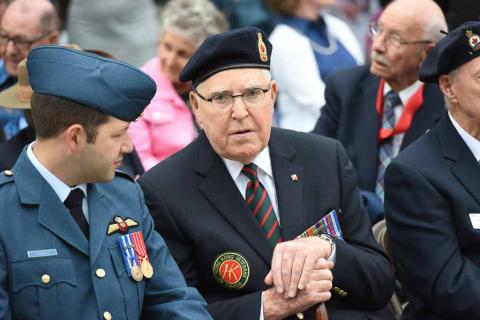
In the 1930s the militia was important to a small town like Listowel, MacDonell explained. With the country exiting a depression, militias were popular with young men who had limited opportunities.
MacDonell had served for almost a year before the outbreak of the Second World War.
“We mobilized within a week of the war for a parade, and each militia member was given a chance to step forward and enlist,” he says.
Not yet 19, MacDonell wasn’t sent overseas. Instead he trained as a weapons expert, before joining a newly formed regiment in Quebec City, the Royal Rifles of Canada, as one of its principle weapon instructors.
“A week after we left B.C. we were told that we were travelling to Hong Kong.”
The Royal Rifles were sent to Newfoundland to guard the Gander airport, before acting as coastal defence troops in Atlantic Canada. The regiment continued to train for, at least what they thought was, their pending deployment to Europe.
In October 1941 they were told that they were heading overseas. After a week of leave, they took a train to British Columbia, before sailing across the Pacific.
“A week after we left B.C. we were told that we were travelling to Hong Kong,” MacDonell says. “We knew nothing [of Hong Kong], we were a bunch of small town kids, who hadn’t finished high school, but we were happy we were going to be involved with what we enlisted for.”
It took 21 days to reach Hong Kong. The Canadian regiments arrived in mid-November, and immediately went to work fortifying its defences.
The Royal Rifles of Canada, and the Winnipeg Grenadiers, had only a few weeks before a Japanese surprise attack ignited a hard fought and bloody battle to defend the then British Crown Colony on the morning of 8 December 1941.
“It began as an air attack and was a complete surprise,” MacDonell says.
They were severely outnumbered. The Japanese first seized the mainland, then the island’s high ground. Controlling the sea and the sky the Japanese attacked repeatedly, but were held off by the Canadian and Allied forces, until 25 December 1941.
“The governor surrendered the island on Christmas Day, 1941, and we were ordered to then surrender. We didn’t surrender until roughly eight o’clock that night, as we were penned up in the highland around Hong Kong,” MacDonell says.

George MacDonell at a ceremony commemorating the 72nd anniversary of the Battle of Hong Kong
The Japanese withdrew from Hong Kong for two days, during which the Canadians buried their dead and destroyed their military equipment. They were marched to a prison camp called North Point, which was a converted welfare institute in Hong Kong.
“After a few months a plague broke out and we were moved to the mainland, and those who were well enough to walk were shipped to the Japanese mainland to engage in slave labour, usually in Japanese mines,” he says.
“We went to work in a giant Japanese shipyard which built Japanese naval vessels and was a vital part of the Japanese war effort. At one point two Canadian [prisoners of war] decided to burn it down, and ignited a fire which shut down one of the largest shipyards in Japan at the time,” MacDonell says.
They were sent to smaller camps all over Japan. MacDonnell, sent to a camp called Ohashi in northern Japan, was forced to mine iron ore. It was here, on 15 August 1945, that he learned of the Japanese surrender, through the emperor’s speech, and they were no longer prisoners of war.
“The story of Hong Kong is not how Canadians were defeated at Hong Kong, but how they fought with courage and distinction against an overwhelming force.”
With their prison camp isolated in the mountains, MacDonell and his fellow POWs weren’t certain they would be found. Luckily, an Allied reconnaissance plane saw their painting of white, five metre letters which spelt P-O-W on the roof of their prison camp buildings. For almost a month, Allied command airdropped food, clothing and medicine to keep them alive until they were reached.
“We had been there too long to survive the next winter, I was down to something like 138 pounds,” says MacDonell.
“Thirty-five percent of Allied soldiers died in Japanese labour camps. They were fed about 1,200 calories a day, so many of them died of starvation, disease or mistreatment.”
Taken to an American hospital ship, they set sail for Guam and it’s military hospitals. After Guam, MacDonell recovered with other Canadians at a military hospital in Gordon Head, on Vancouver Island. By Christmas 1945, he finally returned home to Ontario, for a week’s leave, before returning to a military hospital.
“Our families had written us all off, the Japanese didn’t tell the outside world what happened,” he says. “They were delighted and shocked that some of us had survived.”
“The story of Hong Kong is not how Canadians were defeated at Hong Kong, but how they fought with courage and distinction against an overwhelming force,” MacDonell says. “It’s a story of how they never surrendered and fought with distinction and courage until they were ordered to stop, and gave an amazing account of themselves.”
As we mark the 75th anniversary of V-J Day and the end of the Second World War, and honour the bravery and sacrifices shown by Canadians in Asia and the Pacific, George MacDonell is this week’s Face of Freedom.
Learn more about George MacDonell through his Heroes Remember interviews.
With courage, integrity and loyalty, George MacDonell has left his mark. He is one of our Canadian Veterans. Discover more stories.